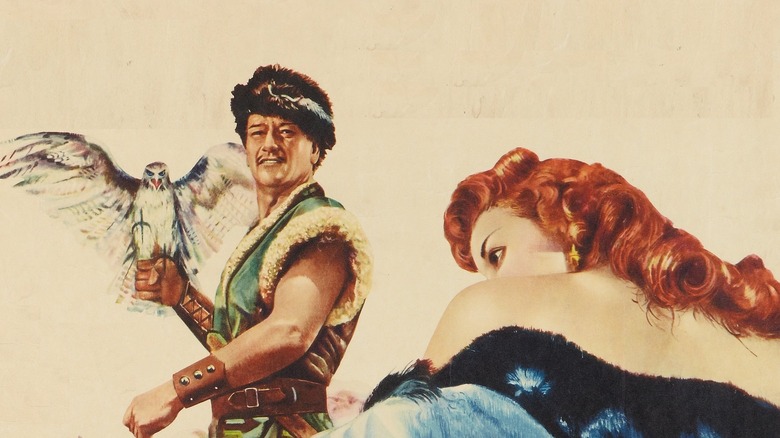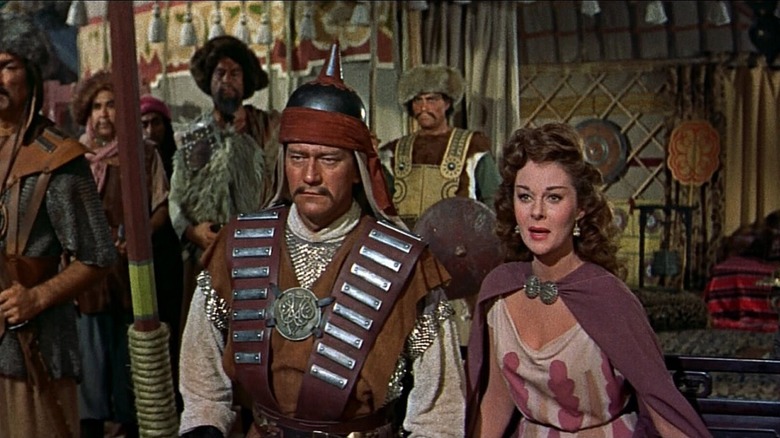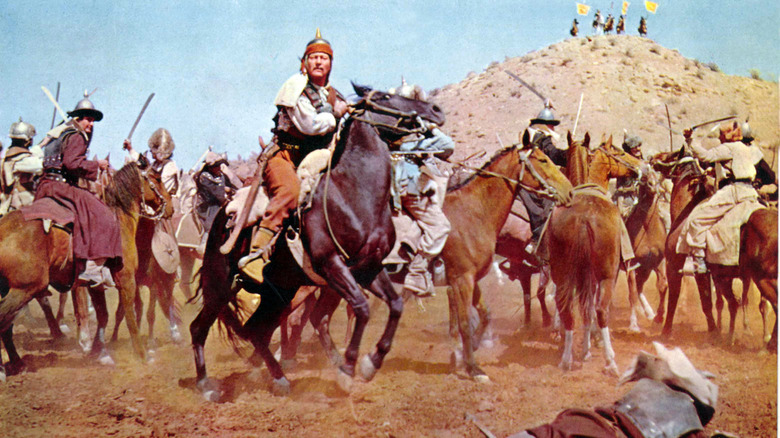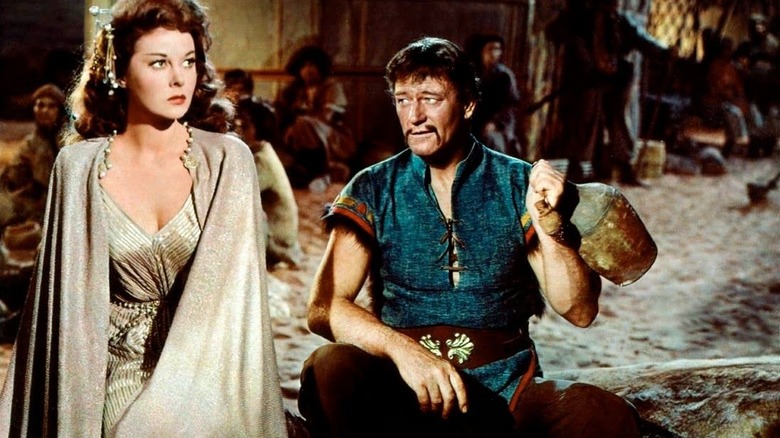The Forgotten John Wayne Film That Left A Tragic Legacy
Dick Powell's 1956 historical epic "The Conqueror" is one of the more notorious duds of the 1950s. It went famously over-budget, and while it did manage to make its money back, it was lambasted by critics at the time, mostly for its grievous miscasting of John Wayne as Genghis Khan. If you ever wanted to hear the Mongol leader Temujin with a Southern drawl, this film is a gift to you and you alone. The New York Times cited its bad script as a source of unintentional comedy, and John McCarten in The New Yorker mentioned that the many, many horses who fall down in the movie are more entertaining than anything the human actors do. "The Conqueror" has appeared in books covering the worst films of all time (most notably in "The Fifty Worst Films of All Time" by Michael Medved, Harry Medved, and Randy Dreyfuss). It was also the second-to-last film produced by Howard Hughes, who, after production, reportedly paid $12 million of his own money to buy every print of "The Conqueror" and keep it comfortably out of the public eye. Universal would eventually buy the rights to the film in 1979.
But it wasn't just its shameful critical reception that left "The Conqueror" radioactive. Additionally, the production was wracked by actual radiation. The exterior scenes for "The Conqueror" were filmed in the desert outside of St. George, Utah, which is a mere 137 miles downwind of the Nevada National Security Site U.S. Government's most-used nuclear testing facility. In the years after production, almost half of the film's cast and crew — including Wayne, Susan Hayward, Agnes Moorehead, and director Powell — contracted cancer. "The Conqueror" was literally filmed under a cloud.
Operation Upshot-Knothole
Between 1951 and 1962, over 100 atomic bombs were detonated at the Nevada National Security Site, with 11 being tested in 1953 alone as part of a special battery of tests called Operation Upshot-Knothole, which was an attempt to find a way to fire nuclear devices from a grounded cannon as opposed to dropping them from a airplane. To add a whiff of satire to the real-life devestation, the bombs in the test all had cute names like Annie, Ruth, and Dixie. Operation Upshot-Knothole was conducted the year before "The Conqueror" was in production. While the Atomic Energy Commission assured the studio, and local residents, that testing nuclear bombs was 100% safe, not a lot about the long-term effects of radiation were yet known, and the effects of nuclear fallout hadn't yet been studied. While "The Conqueror" was experiencing a difficult shoot, nuclear fallout was gently drifting over on the winds. The filmmakers were indeed aware of the nuclear testing, but the full effects of radiation wouldn't be known for years thereafter. A year later, we'd have to contend with Godzilla.
Howard Hughes, in order to save time and money, staged the reshoots for "The Conqueror" in Hollywood. To maintain visual consistency, however, Hughes shipped in 60 tons of dirt from the original Utah location, itself also irradiated. That soil is now spread around an industrial park somewhere in Culver City, CA.
The radiation levels from the NNSS was, according to some nuclear scientists, 10 times greater than that of the Chernobyl disaster.
Downwinders
In the years following the filming of "The Conqueror," members of the cast and crew became very sick. Actor Pedro Armendáriz developed terminal kidney cancer in 1960 and, upon learning the condition was fatal, died by suicide in 1963. That same year, Dick Powell died of lymphatic cancer at the age of 53. Susan Hayward, over the course of the 1970s, developed skin, breast, and uterine cancers before dying of brain cancer in 1974 at the age of 56. Agnes Moorehead died of uterine cancer in 1974, and John Wayne grappled with lung, throat, and stomach cancer for years and died in 1979.
An investigation by People Magazine in 1980 found that 91 of the 220 people on the set of "The Conqueror" had developed some form of cancer, and that 46 of them had died. While it's been argued that there is no direct connection between the nuclear testing and the national average of people contracting cancer, the leukemia rates in St. George were in fact five times higher than the national average. There were several attempts to sue the government over what they knew about the dangers of radiation, but it wouldn't be until 1990 that then-president Bush would begin paying financial reparations to those who were made sick by, or those who lost relatives to, nuclear testing. The victims of nuclear fallout caused by American weapons testing called themselves downwinders. As of 2018, downwinders have received over $2.2 billion in compensation.
Howard Hughes' Guilt
It's been postulated that Howard Hughes bought up all the prints of "The Conqueror" out of guilt for having killed nearly half of the cast and crew, and that doesn't even include family members of the cast and crew; John Wayne's two sons visited the set, and both also eventually developed cancer. Advocates for downwinders have pointed out that radioactive damage can alter DNA, increasing risk for intergenerational infection as well.
Hughes reportedly spent many years in isolation wrestling with mental illness and wracked by intense phobias of the world. Stories go that Hughes watched "The Conqueror" in his private screening room repeatedly. Perhaps Hughes was enacting a twisted form of penance for having made a notorious Hollywood turkey that actually killed almost 100 people.
"The Conqueror," perhaps unsurprisingly, is not available to stream anywhere online.



